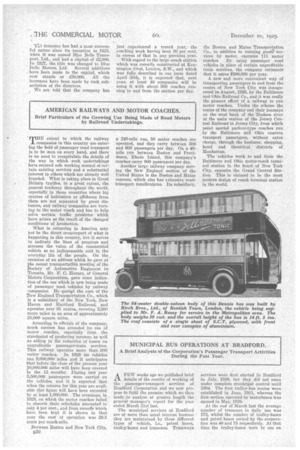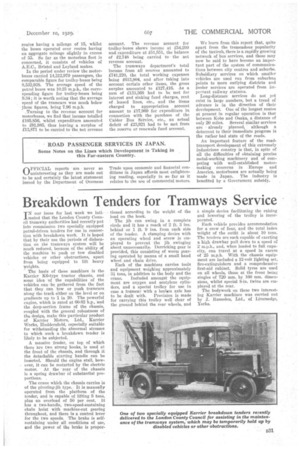MUNICIPAL BUS OPERATIONS AT BRADFORD.
Page 66

Page 67

If you've noticed an error in this article please click here to report it so we can fix it.
A Brief Analysis of the Corporation's Passenger Transport Activities During the Past Year.
AFEW weeks ago we published brief details of the results of working of the passenger-transport services of Bradford Corporation and we now propose to fulfil the promise which We thou made to analyse at greater length the general manager's report for the year ended March 31st last.
The municipal services at Bradford are of more than usual interest because they are maintained by three different types of vehicle, i.e., petrol buses, trolley-buses and tramcars. Tramways services were first started in Bradford in July, 1898, but they did not come under complete municipal control until 1904. The first trolley-bus routes were established in June, 1911, whereas the first section operated by motorbuses was opened in May, 1926.
At the cud of March last the average number of tramcars in daily use was 173, whilst the number of trolley-buses and petrol buses owned by the corporation was 40 and 75 respectively. At that time the trolley-buses were in use on routes having a mileage of 15, whilst the buses operated over routes having an aggregate mileage slightly in excess of 55. So far as the motorbus fleet is concerned, it consists of vehicles of A.E.C., Bristol and Leyland makes.
In the period under review the motorbuses carried 14,312,979 passengers, the comparable figure for trolley-buses being 8,532,938. The average speed of the petrol buses was 10.25 m.p.h., the corresponding figure for trolley-buses being 9.34 ; it is worth noting that the average speed of the tramcars was much below these figures, being 7.96 Turning to the revenue account for motorbuses, we find that income totalled £105,856, whilst expenditure amounted to £91,985, thus leaving a surplus of £13,871 to be carried to the net revenue
account. The revenue account for trolley-buses shows income at £54,299 and! expenditure at £51,551, the balance of 2,748 being carried to the net revenue account.
The tramways department's total income from all sources amounted to £741,220, the total working expenses being £613,804, and after taking into account certain other items, the gross surplus amounted to £127,416. As a sum of £133,368 had to be met for interest and sinking fund charges, rent of . leased lines, etc., and the items charged to appropriation account amount to £17,969 for expenditure in connection with the purchase of the Calder Bus Service, etc., an actual deficit of £23,021 had to be met from the reserve or renewals fund account.
We learn from this report that, quite apart from the tremendous popularity of the taxicab, there is a rapidly growing network of bus services, and these may now be said to have become an important part of the system of communications between city centres and suburbs. Subsidiary services on which smaller vehicles are used run from suburban points to more outlying districts and feeder services are operated from haportent railway stations.
Long-distance services do not yet exist in large numbers, but a trend of advance is in the direction of their development. One of the longest routes at present in regular operation is that between Kobe and Osaka, a distance of only 20 miles. Several similar services are already planned, although a deterrent to their immediate progress is the rather bad state of the roads.
An important feature of the roadtransport development of this extremely industrious country is that, in spite of all the difficulties of obtaining precise metal-working machinery and of competing with well-established motormaking concerns in Europe and America, motorbuses are actually being made in Japan. The industry is benefited by a Government subsidy.
























































































































